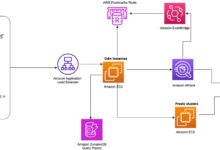AWS Cloud Practitioner Certification: 7 Ultimate Benefits Revealed
Kickstarting your cloud career? The AWS Cloud Practitioner Certification isn’t just a badge—it’s your golden ticket to mastering cloud fundamentals and unlocking high-demand tech roles. Simple, credible, and globally recognized.
What Is the AWS Cloud Practitioner Certification?

The AWS Certified Cloud Practitioner is Amazon Web Services’ entry-level certification designed for individuals who want to demonstrate a solid understanding of the AWS Cloud. It’s perfect for non-technical roles, aspiring cloud professionals, or anyone looking to validate foundational cloud knowledge.
Who Should Take This Certification?
This certification is ideal for a wide range of professionals, not just developers or IT experts. Whether you’re in sales, project management, finance, or just starting your tech journey, the AWS Cloud Practitioner Certification gives you the credibility to speak confidently about cloud solutions.
- Business analysts wanting to understand cloud cost models
- Sales and support staff engaging with AWS-based clients
- Students exploring cloud computing careers
- Managers overseeing cloud migration projects
According to AWS’s official certification page, this credential validates your ability to articulate core AWS services, security, pricing, and support models.
Prerequisites and Exam Requirements
One of the biggest advantages of the AWS Cloud Practitioner Certification is that it has no mandatory prerequisites. However, AWS recommends at least six months of exposure to AWS Cloud—whether through hands-on experience, training, or self-study.
The exam, known as CLF-C02 (as of 2023), consists of 65 multiple-choice and multiple-response questions, with a time limit of 90 minutes. You need a score of 700 out of 1000 to pass.
“The Cloud Practitioner exam is designed to test breadth over depth—focus on understanding the ‘why’ behind AWS services, not just the ‘how.'” — AWS Certification Team
Why Pursue the AWS Cloud Practitioner Certification?
Earning the AWS Cloud Practitioner Certification is more than just adding a line to your resume. It’s a strategic move that opens doors across industries and functions. Let’s dive into the tangible and intangible benefits.
Industry Recognition and Credibility
AWS is the world’s leading cloud provider, with over 32% of the global cloud market share (Synergy Research Group, 2023). Holding an AWS certification instantly boosts your professional credibility. Employers recognize AWS credentials as a benchmark for cloud competence.
Many job postings, even for non-technical roles, now list AWS Cloud Practitioner Certification as a preferred or required qualification. It shows initiative, technical awareness, and a commitment to staying relevant in a digital-first world.
Improved Job Opportunities
LinkedIn data shows that cloud skills are among the top 10 most in-demand skills globally. With the AWS Cloud Practitioner Certification, you position yourself as a candidate who understands digital transformation at a foundational level.
- Cloud Support Associate at AWS partners
- Technical Sales Representative
- IT Project Coordinator
- Cloud Business Analyst
Companies like Accenture, Deloitte, and IBM actively seek certified professionals for entry-level cloud roles. The certification acts as a differentiator in competitive job markets.
Higher Salary Potential
While the AWS Cloud Practitioner is an entry-level cert, it can still impact your earning potential. According to Burning Glass, professionals with AWS certifications earn up to 28% more than their non-certified peers.
Entry-level cloud roles for certified practitioners average $65,000–$85,000 annually in the U.S., with higher figures in tech hubs like San Francisco and Seattle. While experience drives long-term salary growth, certification often serves as the first salary bump catalyst.
Exam Structure and Core Domains
To succeed in the AWS Cloud Practitioner Certification exam, you need to understand its structure and the four core domains it covers. Each domain carries a different weight, so strategic preparation is key.
Domain 1: Cloud Concepts (24%)
This section tests your understanding of fundamental cloud principles. You’ll need to explain the benefits of cloud computing, such as elasticity, scalability, and cost-efficiency.
- Differentiate between on-premises, hybrid, and cloud environments
- Explain the shared responsibility model
- Understand the difference between IaaS, PaaS, and SaaS
- Describe the advantages of high availability and fault tolerance
For example, AWS’s global infrastructure—comprising Regions, Availability Zones, and Edge Locations—enables businesses to deploy applications closer to users, reducing latency and improving performance.
Domain 2: Security and Compliance (26%)
Security is a top concern for organizations moving to the cloud. This domain is the largest section of the exam, emphasizing AWS’s robust security model.
- Understand AWS Identity and Access Management (IAM) basics
- Explain encryption at rest and in transit
- Know the purpose of AWS Key Management Service (KMS)
- Recognize compliance programs like GDPR, HIPAA, and SOC
- Describe AWS Artifact and its role in compliance reporting
AWS operates under a shared responsibility model: AWS manages security of the cloud (hardware, software, facilities), while customers manage security in the cloud (access controls, data encryption).
“Security in the cloud is a shared responsibility—know where AWS’s role ends and yours begins.” — AWS Well-Architected Framework
Domain 3: Technology (34%)
This is the most technical domain, but don’t panic—it focuses on breadth, not depth. You won’t be coding or configuring services, but you must recognize what each service does and when to use it.
- Compute: EC2, Lambda, Elastic Beanstalk
- Storage: S3, EBS, Glacier
- Databases: RDS, DynamoDB
- Networking: VPC, Route 53, CloudFront
- Management Tools: CloudWatch, AWS Config, Trusted Advisor
For instance, Amazon S3 is object storage ideal for backups and static websites, while Amazon EBS is block storage attached to EC2 instances for persistent data.
A helpful resource is the AWS Products page, which categorizes services by function and use case.
Domain 4: Billing and Pricing (16%)
Understanding AWS pricing is crucial, especially for non-technical roles involved in budgeting or procurement. This domain covers cost management tools and pricing models.
- Compare On-Demand, Reserved, and Spot Instances
- Explain the AWS Free Tier and its limitations
- Use the AWS Pricing Calculator for estimates
- Understand the AWS Cost Explorer and Budgets
- Recognize the benefits of Savings Plans
For example, Reserved Instances offer significant discounts (up to 75%) for long-term usage, while Spot Instances allow you to bid on unused EC2 capacity at steep discounts—ideal for fault-tolerant workloads.
How to Prepare for the AWS Cloud Practitioner Certification
Success in the AWS Cloud Practitioner Certification exam doesn’t require months of study, but it does require a structured approach. Here’s how to prepare effectively, whether you have technical experience or not.
Step 1: Define Your Study Plan
Start by assessing your current knowledge. If you’re new to AWS, allocate 4–6 weeks for preparation. Dedicate 5–10 hours per week to studying.
- Week 1–2: Cloud concepts and AWS global infrastructure
- Week 3: Security, IAM, and compliance
- Week 4: Core AWS services and use cases
- Week 5: Billing, pricing, and cost management
- Week 6: Practice exams and review weak areas
Use a calendar or study tracker to stay on schedule. Consistency beats cramming.
Step 2: Leverage Free and Paid Resources
AWS offers a wealth of free resources to help you prepare. Combine these with third-party platforms for a well-rounded study experience.
- AWS Training and Certification Portal: Offers free digital training, including the “AWS Cloud Practitioner Essentials” course.
- AWS Skill Builder: Provides learning paths, practice exams, and labs. Some content is free; premium access costs $29/month.
- Udemy: Popular courses like Stephane Maarek’s “AWS Certified Cloud Practitioner” have high ratings and affordable pricing.
- YouTube: Channels like FreeCodeCamp and TechWorld with Nana offer full-length review sessions.
For hands-on practice, create a free AWS account (using the AWS Free Tier) to explore the AWS Management Console. Launch an EC2 instance, create an S3 bucket, or set up a CloudWatch alarm to reinforce learning.
Step 3: Take Practice Exams
Practice exams are the most effective way to gauge readiness. They help you get comfortable with the question format and identify knowledge gaps.
- AWS offers one official practice exam for $20
- Third-party providers like Tutorials Dojo and Whizlabs offer affordable mock tests with detailed explanations
When taking practice exams, simulate real conditions: 90 minutes, no distractions, no notes. Aim to score above 80% consistently before scheduling your exam.
Common Mistakes to Avoid
Even smart candidates fail the AWS Cloud Practitioner Certification by making preventable errors. Here are the most common pitfalls and how to avoid them.
Mistake 1: Over-Studying Technical Details
Remember, this is a foundational exam. You don’t need to know how to write IAM policies or configure VPCs. Focus on understanding what services do, not how to implement them.
For example, you should know that Amazon RDS is a managed relational database service, but you don’t need to know SQL commands or backup retention settings.
aws cloud practitioner certification – Aws cloud practitioner certification menjadi aspek penting yang dibahas di sini.
Mistake 2: Ignoring the AWS Shared Responsibility Model
This concept appears frequently in the exam. Many candidates confuse what AWS manages versus what the customer manages.
- AWS manages: Physical security, hardware, host operating system patching
- Customer manages: Application security, IAM policies, data encryption keys
Memorize this model—it’s a guaranteed exam topic.
Mistake 3: Underestimating the Billing Domain
Some candidates focus only on technical services and skip pricing. But Domain 4 (16%) is critical. You must understand cost optimization strategies and tools.
For example, know that AWS Budgets alerts you when spending exceeds a threshold, while Cost Explorer helps visualize and forecast costs.
What Happens After You Pass?
Congratulations—you’ve earned your AWS Cloud Practitioner Certification! But your cloud journey is just beginning. Here’s how to leverage your certification for maximum impact.
Update Your Resume and LinkedIn
Add your certification to your resume under a “Certifications” section. Include the full name, date earned, and certification ID.
On LinkedIn, update your profile headline and add the credential to the “Licenses & Certifications” section. Use the official AWS badge generator to display a verified badge.
Pro tip: Post about your achievement with a short message like, “Proud to earn my AWS Certified Cloud Practitioner! Ready to help organizations harness the power of the cloud.” This boosts visibility and attracts recruiter attention.
Pursue Advanced AWS Certifications
The Cloud Practitioner is the first step in AWS’s certification ladder. Next, consider one of the associate-level certifications:
- AWS Certified Solutions Architect – Associate: For designing distributed systems on AWS
- AWS Certified Developer – Associate: For building and deploying cloud applications
- AWS Certified SysOps Administrator – Associate: For managing and operating systems on AWS
Each of these requires deeper technical knowledge but opens doors to higher-paying roles.
Join the AWS Community
Becoming certified gives you access to exclusive AWS communities, events, and resources.
- Join AWS User Groups (meetups and online forums)
- Attend AWS re:Invent or re:Inforce conferences
- Participate in AWS hackathons and challenges
Networking with other professionals can lead to mentorship, job referrals, and collaborative learning opportunities.
Real-World Impact of the AWS Cloud Practitioner Certification
It’s one thing to pass an exam, but how does the AWS Cloud Practitioner Certification translate to real-world value? Let’s look at a few case studies.
Case Study 1: From Marketing to Cloud Sales
Sarah, a marketing coordinator at a mid-sized tech firm, earned her AWS Cloud Practitioner Certification in 6 weeks. She used her newfound knowledge to contribute to cloud product campaigns and eventually transitioned into a cloud sales role at an AWS partner. Her salary increased by 35% within a year.
Case Study 2: IT Support Technician Gets Promoted
James, an IT support technician with no coding experience, studied AWS fundamentals after work. After passing the exam, he was assigned to support his company’s AWS migration project. His certification demonstrated initiative, leading to a promotion to Cloud Support Specialist.
Case Study 3: Student Lands Internship
Maya, a computer science student, added the AWS Cloud Practitioner Certification to her resume before graduation. During job fairs, she stood out from peers. She secured a cloud internship at a Fortune 500 company, which later turned into a full-time offer.
Future of Cloud Certifications and Career Growth
The demand for cloud skills isn’t slowing down. Gartner predicts that by 2025, 95% of new digital workloads will be deployed on cloud-native platforms. This shift creates massive opportunities for certified professionals.
Cloud Skills Gap Is Real
Despite high demand, there’s a global shortage of skilled cloud talent. According to LinkedIn’s 2023 Jobs Report, cloud computing is the #1 hard skill employers need. The AWS Cloud Practitioner Certification helps bridge that gap by equipping non-technical and technical professionals alike with essential knowledge.
Lifelong Learning in the Cloud Era
Technology evolves fast. AWS regularly updates its services and exams. The CLF-C01 exam was replaced by CLF-C02 in 2023 to reflect new services and best practices.
To stay relevant, certified professionals should:
- Renew their certification every three years
- Stay updated via AWS blogs and webinars
- Explore emerging areas like AI/ML, serverless, and cloud security
The AWS Cloud Practitioner Certification isn’t the end—it’s the beginning of a lifelong learning journey in one of the most dynamic fields in tech.
Is the AWS Cloud Practitioner Certification worth it for beginners?
Absolutely. It’s designed for beginners and provides a solid foundation in cloud concepts, AWS services, security, and pricing. It’s a great way to start your cloud career, even with no technical background.
How long does it take to prepare for the AWS Cloud Practitioner exam?
Most candidates spend 4–6 weeks preparing, dedicating 5–10 hours per week. If you have prior cloud experience, you might need less time. Beginners should allow more time for hands-on practice and concept mastery.
Can I take the AWS Cloud Practitioner exam online?
Yes. AWS partners with Pearson VUE to offer online proctored exams. You can schedule your exam from home or office, provided you meet the technical and environmental requirements (stable internet, quiet room, webcam).
What is the cost of the AWS Cloud Practitioner exam?
The exam fee is $100 USD. AWS occasionally offers exam vouchers through training programs or events. Retakes are allowed, but you must wait 14 days between attempts.
Does the AWS Cloud Practitioner Certification expire?
Yes, it’s valid for three years. You can renew it by passing the current exam or by earning a higher-level AWS certification before your current one expires.
The AWS Cloud Practitioner Certification is more than just a starting point—it’s a career accelerator. Whether you’re looking to switch roles, enhance your resume, or understand the cloud better, this certification delivers real value. With the right preparation, anyone can earn it. The cloud isn’t the future—it’s the present. And with this certification, you’re already ahead of the curve.
aws cloud practitioner certification – Aws cloud practitioner certification menjadi aspek penting yang dibahas di sini.
Further Reading:









